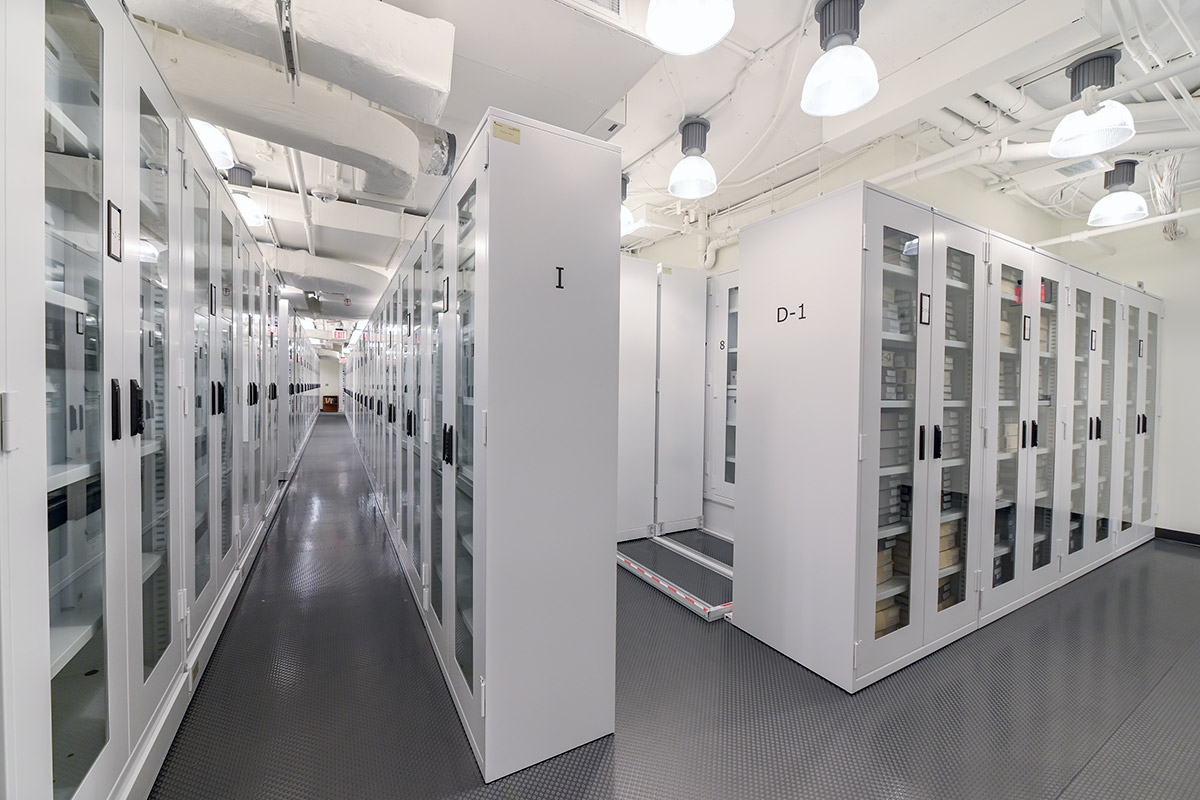When the Ralph Rinzler Folklife Archives and Collections closed to the public on October 1, 2018, Center staff anticipated that it would reopen within the next twelve months after completing three major objectives:
- Replace with more reliable equipment the five failing air-conditioning units that regularly leaked onto the open shelves that housed the archival collections.
- Replace all that open shelving with state-of-the-art cabinetry designed for archival preservation.
- Label and barcode approximately 4,400 archival boxes in the Rinzler Archives—containing hundreds of thousands of photographs, 2,000+ cubic feet of manuscripts and business records, and more than 80,000 unique, fragile audiovisual media items—to make them more secure, traceable, and accessible.
On one hand, this was a construction project. But it was also a cultural project that was key to the Center’s strategic goals and its vision of sustaining the world’s cultural diversity. As Greg Adams, interim director of the Archives explained, “if we did not do this work, we would lose our entire foundation about what it means to build understanding, strengthen communities, and reinforce our shared humanity. If we are supposed to contribute to sustaining the world’s cultural diversity, then that means we also have a responsibility to physically care for, to digitize, to manage, and to make accessible those essential elements of our collections. That is embedded in the DNA of why we do what we do.”
To realize those goals, Center staff needed to carefully move and track every single item from the Archives into temporary storage, after first calculating where there might be available space, and also determining where to store the archival materials that Smithsonian Folkways staff members might need to consult as part of their ongoing processes of production, digitization, and royalty payments. As the collection outgrew the space many years ago, and as Folkways continues to acquire other record labels and researchers generate new materials, Archives staff had to determine which boxes should be managed in offsite facilities. The majority would move back into that same physical space after it was renovated and upgraded.
Not surprisingly, the job of renovating and upgrading the Archives took slightly longer than twelve months to complete. But by March 2020, the Archives was ready for the return of its 4,400 boxes. A contractor to help with the move was already on her way from North Carolina to Washington, D.C., but . . . the coronavirus pandemic had other plans. The contractor had to turn back after hearing that the Smithsonian had suddenly closed its doors.


Stacks in the Rinzler Archives before and after renovation. Photos by Sonya Pencheva, Ralph Rinzler Folklife Archives
The return of the archival materials finally began in June 2020, with the largest tranche of boxes—approximately 3,600—placed inside new cabinetry underneath an entirely new system for heating, ventilation, and air conditioning. However, the Smithsonian—like much of the world—was still largely in isolation. It took another two years for the Archives to welcome its first outside researcher—an American studies professor from George Washington University, followed by others, including a PhD candidate from University of California, Santa Barbara, and a fellow from the International Information and Networking Center for Intangible Cultural Heritage in the Asia-Pacific Region. The Archives is now open by appointment Monday through Friday, 10 a.m. to 5 p.m., except for federal holidays.
“In too many places around the world, archives are treated as after thoughts and collections are left to languish in spaces that do not support their long-term care,” Adams observed. “But this construction project demonstrated the Smithsonian’s commitment to collections care excellence.” Getting the job done, according to Adams, took even more than the proverbial village. “It took almost a city.”
Playing key roles with Center staff were more than a hundred people from a dozen different Smithsonian units and external partners, including Boston Properties, Gibbs Contracting, HBW Construction, Smithsonian Libraries and Archives, Smithsonian Office of Facilities Management and Reliability, Smithsonian Office of Planning, Design, and Construction, Smithsonian Office of Protection Services, Smithsonian Office of Safety, Health, and Environmental Management, Spacesaver Interiors, and WJ Architects. Funding for the project came from Smithsonian Office of Planning, Management, and Budget and the Smithsonian National Collections Program’s Collections Care Initiative.

James Deutsch is a curator at the Center for Folklife and Cultural Heritage. He has used the rich resources of the Rinzler Archives to conduct research on many different projects, several of which have previously appeared in Folklife Magazine.


